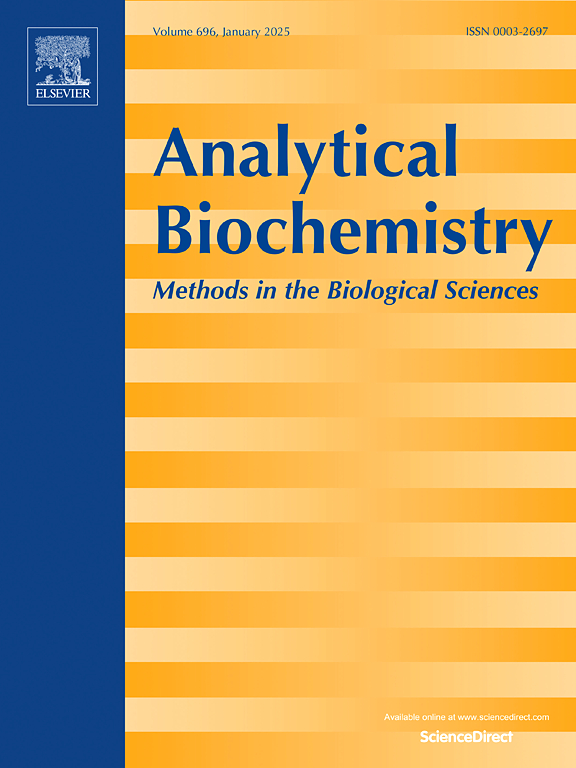Absolute quantitation of neopterin as an endogenous pharmacodynamic Biomarker: The successful method development, validation, and use of a surrogate matrix for clinical sample analysis
IF 2.5
4区 生物学
Q2 BIOCHEMICAL RESEARCH METHODS
引用次数: 0
Abstract
Biomarkers are playing an increasing role in the drug discovery and drug development process. Molecular biomarkers pose a bioanalytical challenge due to their low concentrations and endogenous presence. Inaccurate quantitation could lead to biased study results. Surrogate analyte and surrogate matrix approaches can be used to overcome the lack of a blank matrix and provide accurate quantitation. However, the suitability of the surrogate analyte or matrix must be established during method validation. Here we describe the development and validation of a surrogate matrix approach for the absolute quantitation of neopterin as a PD biomarker for use in an FDA-sponsored clinical study (NCT04183491). Matrix suitability was established through parallelism, precision and accuracy, and internal standard response. Parallelism experiments showed FBS, and serum had identical slopes 0.0145. Additionally, the difference in the X-intercepts was able to accurately predict the amount of endogenous neopterin (1.0 ng/mL). Inter-day accuracy across four surrogate QC levels ranged from 92.08 to 109.06 % while precision ranged from 3.36 to 16.00 %. Inter-day accuracy for the QCs in study matrix ranged from 96.81 to 108.86 % and precision ranged from 4.13 to 6.01 %. The internal standard response in FBS was only 6.9 % different from serum. Additionally, there was no matrix effect, injection carryover, or cross-analyte interference observed. The method was then qualified for automated sample processing.

新蝶呤作为内源性药效学生物标志物的绝对定量:成功的方法开发、验证和临床样品分析替代基质的使用
生物标志物在药物发现和药物开发过程中发挥着越来越重要的作用。分子生物标志物由于其低浓度和内源性存在,对生物分析提出了挑战。不准确的定量可能导致有偏差的研究结果。替代分析物和替代矩阵方法可用于克服空白矩阵的缺乏,并提供准确的定量。然而,替代分析物或基质的适用性必须在方法验证期间确定。在这里,我们描述了一种替代基质方法的开发和验证,该方法用于新蝶呤作为PD生物标志物的绝对定量,用于fda资助的临床研究(NCT04183491)。通过并行度、精密度和准确度以及内标响应等指标确定了矩阵的适用性。平行实验结果表明,FBS与血清斜率相同,均为0.0145。此外,x截距的差异能够准确预测内源性新蝶呤的量(1.0 ng/mL)。四个替代QC水平的日间准确度范围为92.08至109.06%,而精密度范围为3.36至16.00%。研究基质中质量指标的日间准确度为96.81 ~ 108.86%,精密度为4.13 ~ 6.01%。FBS内标反应与血清内标反应仅相差6.9%。此外,没有观察到基质效应、注射残留或交叉分析干扰。该方法可用于自动样品处理。
本文章由计算机程序翻译,如有差异,请以英文原文为准。
求助全文
约1分钟内获得全文
求助全文
来源期刊

Analytical biochemistry
生物-分析化学
CiteScore
5.70
自引率
0.00%
发文量
283
审稿时长
44 days
期刊介绍:
The journal''s title Analytical Biochemistry: Methods in the Biological Sciences declares its broad scope: methods for the basic biological sciences that include biochemistry, molecular genetics, cell biology, proteomics, immunology, bioinformatics and wherever the frontiers of research take the field.
The emphasis is on methods from the strictly analytical to the more preparative that would include novel approaches to protein purification as well as improvements in cell and organ culture. The actual techniques are equally inclusive ranging from aptamers to zymology.
The journal has been particularly active in:
-Analytical techniques for biological molecules-
Aptamer selection and utilization-
Biosensors-
Chromatography-
Cloning, sequencing and mutagenesis-
Electrochemical methods-
Electrophoresis-
Enzyme characterization methods-
Immunological approaches-
Mass spectrometry of proteins and nucleic acids-
Metabolomics-
Nano level techniques-
Optical spectroscopy in all its forms.
The journal is reluctant to include most drug and strictly clinical studies as there are more suitable publication platforms for these types of papers.
 求助内容:
求助内容: 应助结果提醒方式:
应助结果提醒方式:


